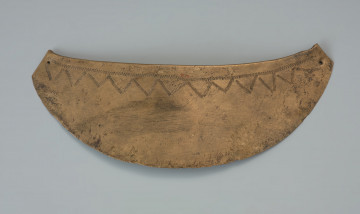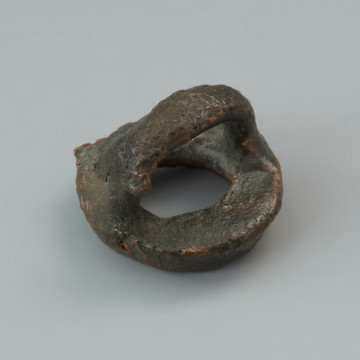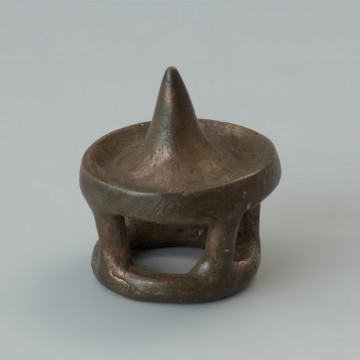
A crescent razor
around 750 p.n.e. — 550 p.n.e.
National Museum in Szczecin
Part of the collection: Bronze Age
The mould was made of bronze and consists of two parts called shells. This unusual object was used to make small axes with an eye and a socket, in which a wooden handle was attached. The mould was found in 1884 in a swamp. It was an element of a large hoard that included parts of a horse tack (2 twin bits, 14 jingles , 14 buttons, 3 rings), two pairs of moulds for casting axes, three fibulae, an impressive razor and destructs of some bronze and iron products. The marshy context of the hoard may attest to its special significance connected with the sphere of beliefs and sacrificial offerings. The deposit, dated to the Early Iron Age (approx. 750-600/550 BC), found its way to the museum collection in Szczecin and was stored there until August 1944. Due to the approaching front and Allied air raids, it was transported deep into Germany together with other valuable artefacts. The hoard did not return to Szczecin until 2009, which was possible due to the Polish-German exchange of old (pre-war) archaeological collections. Most of the items found in the Kiełpino deposit have features of the products of the Hallstatt culture, whose name derives from the cemetery in Hallstatt, Austria. However, the presented casting mould is an exception, as the type of axe it produced refers to specimens known from the northern part of Central Europe. It should be emphasised that bronze casting moulds are rare finds in Poland. So far, only ten specimens have been recorded.
Dorota Kozłowska
Author / creator
Dimensions
the entire object: height: 9 cm, width: 5 cm
Object type
casting mold
Technique
casting
Material
bronze
Origin / acquisition method
legal transfer
Creation time / dating
Creation / finding place
Owner
National Museum in Szczecin
Identification number
Location / status

around 750 p.n.e. — 550 p.n.e.
National Museum in Szczecin

around 750 p.n.e. — 550 p.n.e.
National Museum in Szczecin

around 750 p.n.e. — 550 p.n.e.
National Museum in Szczecin
DISCOVER this TOPIC
Castle Museum in Łańcut
DISCOVER this PATH
Educational path